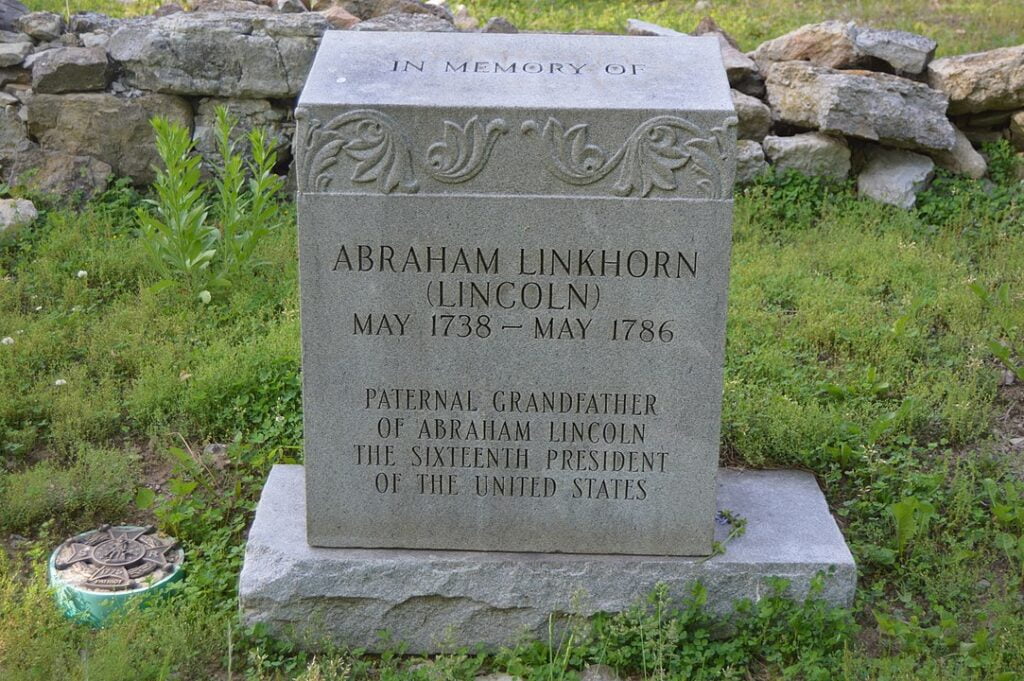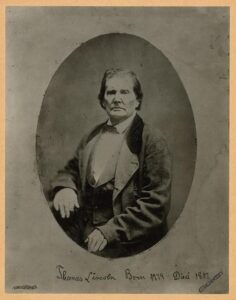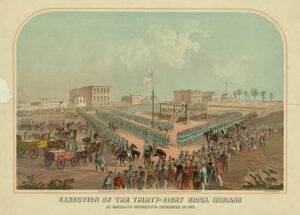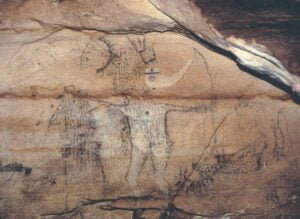Abraham Lincoln’s Grandfather was murdered

The modern gravestone for Abraham Lincoln's grandfather.
In the 1780s, relations between Native Americans and encroaching pioneers in the Ohio Valley were tense. In 1786, a Native American man shot and killed the grandfather of Abraham Lincoln (also named Abraham Lincoln) at the Lincoln farm in Kentucky. The murder left Thomas Lincoln, the future President’s father, in a childhood of poverty and hardship.
Abraham Lincoln, in an 1854 letter written to a relative regarding family lore, remarked that this story “is the legend more strongly than [most prominent of] all other imprinted on my mind and memory.”
Kentucky in the 1700s
By the 1770s, surveyors trickled into Kentucky, which was part of the Virginia? Colonists weren’t far behind. These settlers weren’t the fur trappers and hunters that previously ventured into Kentucky. The new settlers created permanent settlements and brought their goods, families, and slaves. They were Christian and believed the native residents they saw as primitive savages, needed to be converted.
Kentucky was occupied by tribes including the Shawnee, Miami, and Cherokee. Relations between the encroaching settlers and the tribes quickly soured. The tribes set up raiding parties that attacked settler caravans and homesteads. The Anglo-American settlers retaliated and transformed their settlements into walled fortresses.
Tribes including the Shawnee and Cherokee allied themselves with the British during the American Revolutionary War. They hoped their partnership with the British would stop the influx of settlers into their lands.
In 1777, nicknamed the “Year of the Terrible Sevens,” native raiding expeditions intensified in both brutality and frequency. Out of fear, the colonists nearly abandoned Kentucky between 1777 and the end of the Revolutionary War in 1783.
In 1784, John Filson published a popular book called, The Discovery, Settlement, and the present state of Kentucky. It encouraged settlers to come to Kentucky. He referred to Kentucky as the “Dark and Bloody Ground” and an “object of contention.” Settlers, with the fear of Native American brutality on their minds, became hyper-vigilant, leading to later atrocities.

Captain Abraham Lincoln’s background
Abraham Lincoln had served as a Captain in the Virginia Militia during the Revolutionary War. Lincoln heard enthralling stories of the bountiful land of Kentucky from trappers and his acquaintance, Daniel Boone.
Lincoln, received treasury warrants for land in Kentucky in exchange for his military service. He acquired a four-hundred-acre tract near Hughes Station in eastern Jefferson County, Kentucky (then Virginia) in 1780.
In 1782, Lincoln with his family, including his young son Thomas, ventured into the land beyond the Cumberland Gap.
Abraham Lincoln’s 1786 Murder
In May 1786, Abraham Lincoln’s Grandfather was working in his field with his three sons. A Native American man, hiding in the forest, shot Lincoln. When Lincoln fell to the ground, dead, the eldest son, Mordecai, ran to the cabin to grab a loaded gun. The middle son, Josiah, ran to nearby Hughes’ Station for help. Thomas, then about five years old, stood next to his father’s body when the assailant lunged toward the young boy. Meanwhile, Mordecai positioned his rifle in a slit in the log cabin wall. Mordecai aimed for a silver pendant on the man’s chest and fired, killing the man.

Thomas Lincoln is forced into a life of hardship
Thomas was left without his parents. Years earlier, his mother died. His remaining family and widowed stepmother moved to Nelson County, Kentucky. Abraham’s elder sons inherited his properties.
Thomas was no longer an heir to a well-to-do family. He missed out on a proper education and lived a childhood of hard labor. By age 19, Thomas joined the state militia.
Years later, Thomas’ son, Abraham, would occasionally deride his father as being a simple, uneducated man.
However, like the future President, Thomas had a knack for storytelling. Friends of the family recall that Thomas enjoyed entertaining company with vivid accounts of his father’s murder and other encounters with Native Americans.
Mordecai Lincoln
Lincoln’s Uncle Mordecai was also deeply affected by the murder. Mordecai despised Native Americans. According to a neighbor, Mordecai often bragged about killing a Native American man who passed through his Kentucky town. Mordecai saw it as an act of avenging his father. There are other accounts regarding Mordecai killing Native Americans. in Grayson County,
Mordecai’s nephew, Abraham visited him often and once said that “Uncle Mord had run off with all the talents of the family.” In contrast to Thomas, Mordecai was known for having a keen intellect and a witty sense of humor, qualities Abraham admired.
Abraham Lincoln’s Complicated Relationship with Native Americans
Abraham heard the story of his grandfather’s murder throughout his childhood. However, the first recorded incident of Lincoln encountering a Native American in person happened during Lincoln’s militia service during the Blackhawk War. His militia hosted a group of Cherokee tribesmen that arrived under terms of peace.
William Miller, a militia officer also from Sangamon County, described the meeting: “This was the first Indians we saw they was verry friendly and gave us a general war Dance we in return gave them a sucker [Illinois] Ho down all enjoyed the sport and It is safe to say no man enjoyed it better than Capt Lincoln.”
Later into Lincoln’s service, he witnessed the bodies of American militiamen strewn across the battlefield at Stillman’s Run in Illinois. The defeated, militiamen were scalped and some were decapitated.
Another story recounts Lincoln forcefully stopping officers from lynching an elder Native American messenger. His militia was known to camp with Winnebago and Potawatomi tribesmen, where Lincoln displayed his wrestling skills.
However, throughout Lincoln’s time in the U.S. House of Representatives, he supported Indian removal policies.
During his Presidency, he ordered the largest execution of indigenous people in American history. 260 men were given a reprieve. He eventually signed off on executions for 38 men.

He signed the Homestead Act and the Pacific Railroad Act, which handed millions of acres of tribal land to settlers and railroad companies.
In March 1863, when hosting Plains Indian dignitaries at the White House, Lincoln told them: “I can see no way in which your race is to become as numerous and prosperous as the white race except by living as they do, by cultivation of the earth.” He also argued, during the Civil War (the deadliest war in American history) that white men were “not, as a race, so much disposed to fight and kill one another as our red brethren.”
In 1863, Lincoln’s administration removed Navajos and Mescalero Apaches from the New Mexico Territory
Overall, Abraham Lincoln saw Native Americans as intriguing but inferior to the white race.
However, this was not unique to Lincoln. In the 19th century, pseudoscientific, racial beliefs were mainstream. These beliefs were spread in universities, prestigious publications, and other esteemed institutions.
To this day, Lincoln’s impact on Native American relations is hardly discussed, in contrast with his legacy on African American rights. But his policies and beliefs regarding Native Americans have also left a significant mark on American history.
Who knows how much of an impact his grandfather’s murder had on American history?
Other Lincoln stories:



